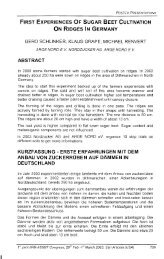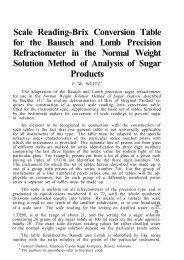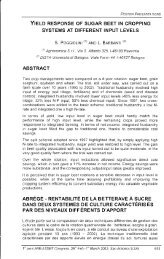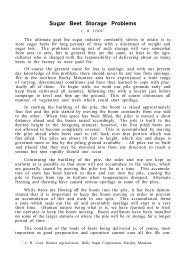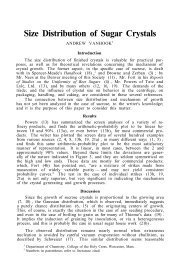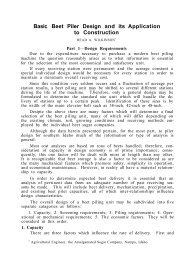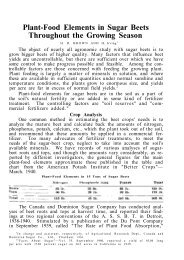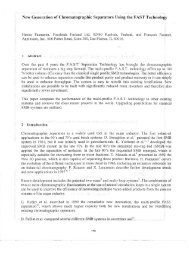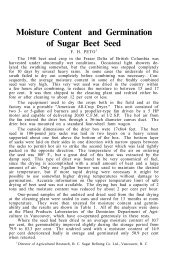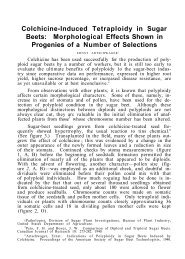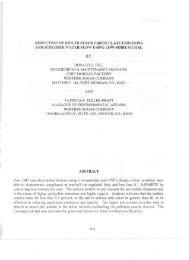Some illustrations of methods in plant breeding - ASSBT Proceedings
Some illustrations of methods in plant breeding - ASSBT Proceedings
Some illustrations of methods in plant breeding - ASSBT Proceedings
You also want an ePaper? Increase the reach of your titles
YUMPU automatically turns print PDFs into web optimized ePapers that Google loves.
Table 5· Yield <strong>in</strong> bushels per acre <strong>of</strong> M<strong>in</strong>hybrids 301, 403 and Murdock,<br />
1937-38.<br />
Location (county)<br />
Brown-Cottonwood<br />
Rock<br />
'rtlaseca-Fa.ri baul t<br />
Fillmore-Houston<br />
Average<br />
B·u. <strong>in</strong>crease over Nu.rdock<br />
-10-<br />
M<strong>in</strong>hybrid<br />
------·--·-----r;:_--·- 301<br />
oOol<br />
66.2<br />
63.0<br />
68.8<br />
64o5<br />
10.7<br />
M<strong>in</strong>hybrid<br />
4o3<br />
Nurd.ock<br />
-«--:::----·<br />
b2 ·5 50.2<br />
70.6 54.1<br />
66o2 53ol<br />
72.4 57·3<br />
67.9<br />
14.2<br />
53·7<br />
The data given <strong>in</strong> tables 4 and 5 shO\'V clearly the vnlue <strong>of</strong> these two<br />
hybrids <strong>in</strong> comparison with open-poll<strong>in</strong>ated varieties thtl.t are similar to these<br />
hybrids <strong>in</strong> dnte <strong>of</strong> maturity.<br />
~reed<strong>in</strong>g Impro~ed Inbred L<strong>in</strong>es <strong>of</strong> Corn<br />
Two <strong>methods</strong> <strong>of</strong> breed<strong>in</strong>g improved <strong>in</strong>bred l<strong>in</strong>es <strong>of</strong> corn are be<strong>in</strong>g used<br />
rather extensively <strong>in</strong> the Corn Belt. These are backcross<strong>in</strong>g and convergent<br />
improvement •<br />
An undesirable ch2.racter <strong>of</strong> the three-way cross, Jvi<strong>in</strong>hybrid 301, is the<br />
suscep ti bili ty to smut <strong>of</strong> tho <strong>in</strong>bred Bl6l~. This <strong>in</strong>bred has been changed by<br />
backcross<strong>in</strong>g. The method may be illustrn.ted as follo'''s:<br />
Impr~vement <strong>of</strong> Bl61~ by _..E.:·wkcro~_r,<strong>in</strong>g with particular reference to smut resist~ce<br />
Early . <strong>in</strong>bre~-' _037<br />
Smut susceptible<br />
Smut resistance<br />
Method<br />
lo (Bl64 X 37) X Bl64<br />
2. [(Bl64 X 37) x Bl6lQ X Bl64<br />
Selection <strong>in</strong> 1 and 2 for smut resistance.<br />
3• Self poll<strong>in</strong>ation and selection (2 years).<br />
4. Select a desirable smut resistant l<strong>in</strong>e resembl<strong>in</strong>g Bl64,<br />
In a field trial <strong>in</strong> 1938 and 1939 several such l<strong>in</strong>es \'lere obta<strong>in</strong>ed that<br />
were highly smut resistant <strong>in</strong> comparison with Bl61~-.<br />
Convergent improvement, first svggested by Hichey ( 16) <strong>in</strong> 1927 ( eq_uivalent<br />
to double back:cross<strong>in</strong>g), is a method <strong>of</strong> improv<strong>in</strong>g each <strong>of</strong> hro <strong>in</strong>breds<br />
v1i thout modify<strong>in</strong>g their comb<strong>in</strong><strong>in</strong>g ability i,rhen crossed together. It may be<br />
illustrated with hro <strong>of</strong> the <strong>in</strong>bred l<strong>in</strong>es used <strong>in</strong> M<strong>in</strong>hybrid 4o3. <strong>Some</strong> <strong>of</strong> the<br />
differential characters <strong>of</strong> the <strong>in</strong>bred l<strong>in</strong>es 11 and 375 are given here.<br />
Characters <strong>of</strong> the parental <strong>in</strong>breds<br />
11<br />
Smut susceptible<br />
Large seed*<br />
Premature germ<strong>in</strong>ation<br />
Fair root system<br />
37~<br />
Smut resistant*<br />
Small seed<br />
Good q_uality see



